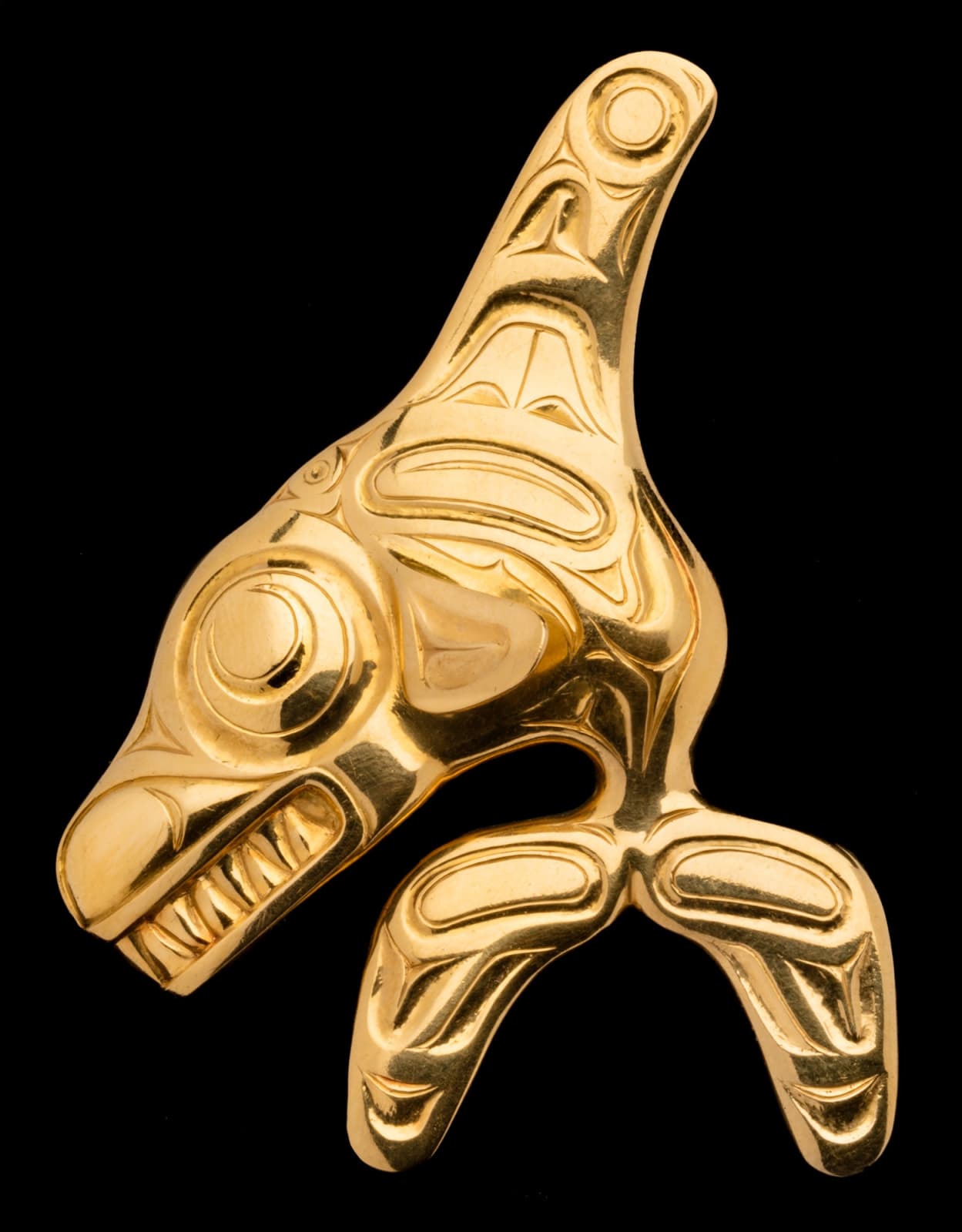-
Artworks
BILL REID (IIJUWAS), O.B.C., R.C.A. (1920-1998), HAIDA
Killer Whale Brooch, 1972testing 22 kt cast gold with chased and engraved highlights, 2.5 x 2 x 0.5 in (6.3 x 5.1 x 1.3 cm) / 21 grams
with artist's Wasgo stamp;
signed, dated, and numbered, ""Reid - '72 / 2/10”*.
*from the planned edition of 10 but only 3 were made, one of which was gifted from Pierre Trudeau to his wife, Margaret.LOT 26
ESTIMATE: $25,000 — $35,000
PRICE REALIZED: $26,400.00Further images
Iijuwas, Bill Reid, was born in Victoria, B.C. in 1920. In the late 1940s he began to pursue his personal interest in jewellery with courses at Ryerson Institute of Technology...Iijuwas, Bill Reid, was born in Victoria, B.C. in 1920. In the late 1940s he began to pursue his personal interest in jewellery with courses at Ryerson Institute of Technology while working as an announcer for CBC Radio in Toronto. At the same time, he was exposed to Haida masterworks in Toronto museums which altered his artistic direction. In 1963 he established a studio in Gastown back in Vancouver, after several years working on monumental projects, to devote time to creating Haida pieces in precious metals. It was during this time that he would produce some of the definitive masterworks of Haida art. Several of these pieces were exhibited at the two major showcases for Northwest Coast art in the 1960s: the Canadian Pavilion at Expo ’67 in Montreal, and the exhibition Arts of the Raven at the Vancouver Art Gallery. In 1968, Reid received a Canada Council grant that allowed him to study goldsmithing at the Central School of Design in London, England, where he learned to add new techniques to Haida and contemporary jewellery pieces. Following his time in London, he established a studio in Montreal where he could quietly pursue his career as an artist; there he carved the boxwood sculpture Raven and the First Men which would become the maquette for the famous seven-foot monumental sculpture for the new UBC Museum of Anthropology. He continued to produce pieces in argillite, wood, and ivory.
Reid was interested in Haida mythology, which he related in compelling stories, and which formed the basis of numerous multi-figured sculptures, drawings, and jewellery pieces. The Killer Whale appears in several myth-based pieces, particularly the story of Nanasimeget and his wife. He also carved the Killer Whale as a solitary figure such as with the Killer Whale Brooch, the monumental Killer Whale for the Vancouver Aquarium, and a sculpted box with an arching killer whale handle in 1971. All three works capture the whale in a similar position, with an exaggerated and heavily designed dorsal fin, an arched back, and riding on its back flukes as it leaves the water. This 1972 Killer Whale Brooch was in a stated edition of ten, but only three were ever cast, hand carved, and finished. The first of the three was gifted by Prime Minister Trudeau to his wife, Margaret.
Gary Wyatt
References: For an early Killer Whale Brooch in gold and shell from 1964 see Martine J. Reid, Bill Reid Collected, (Vancouver: Douglas & McIntyre Ltd., 2016), p. 66; see pp. 92-93 for Killer Whale Earrings and a Killer Whale Box, and p. 118 for a boxwood Killer Whale sculpture by the artist; and finally pp. 124, 126 for a Killer Whale bronze, and the large Killer Whale at the Vancouver Aquarium. Many of these can also be found in Doris Shadbolt, Bill Reid, (Vancouver: Douglas & McIntyre, 1986), pp. 55, 124, 136-139. For an illustration of Bill Reid’s 1984 bronze sculpture Killer Whale in the Vancouver Art Gallery Collection, see Daina Augaitis et al., Raven Travelling: Two Centuries of Haida Art, (Vancouver: Vancouver Art Gallery / Douglas & McIntyre, 2006), cat. 29, p. 42.
Provenance
An Ottawa Collection.
Join our mailing list
* denotes required fields
We will process the personal data you have supplied in accordance with our privacy policy (available on request). You can unsubscribe or change your preferences at any time by clicking the link in our emails.






